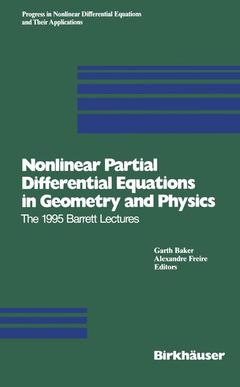Description
Nonlinear Partial Differential Equations in Geometry and Physics, Softcover reprint of the original 1st ed. 1997
The 1995 Barrett Lectures
Progress in Nonlinear Differential Equations and Their Applications Series, Vol. 29
Coordinators: Baker Garth, Freire Alexandre
Language: English
Subjects for Nonlinear Partial Differential Equations in Geometry and...:
Publication date: 10-2012
156 p. · 15.5x23.5 cm · Paperback
156 p. · 15.5x23.5 cm · Paperback
Description
/li>Contents
/li>Comment
/li>
This volume presents the proceedings of a series of lectures hosted by the Math ematics Department of The University of Tennessee, Knoxville, March 22-24, 1995, under the title "Nonlinear Partial Differential Equations in Geometry and Physics" . While the relevance of partial differential equations to problems in differen tial geometry has been recognized since the early days of the latter subject, the idea that differential equations of differential-geometric origin can be useful in the formulation of physical theories is a much more recent one. Perhaps the earliest emergence of systems of nonlinear partial differential equations having deep geo metric and physical importance were the Einstein equations of general relativity (1915). Several basic aspects of the initial value problem for the Einstein equa tions, such as existence, regularity and stability of solutions remain prime research areas today. eighty years after Einstein's work. An even more recent development is the realization that structures originally the context of models in theoretical physics may turn out to have introduced in important geometric or topological applications. Perhaps its emergence can be traced back to 1954, with the introduction of a non-abelian version of Maxwell's equations as a model in elementary-particle physics, by the physicists C.N. Yang and R. Mills. The rich geometric structure ofthe Yang-Mills equations was brought to the attention of mathematicians through work of M.F. Atiyah, :"J. Hitchin, I.
New Directions in 4-Manifold Theory.- Lecture 1: Donaldson and Seiberg-Witten Invariants.- Lecture 2: The Immersed Thorn Conjecture.- Lecture 3: Intersection Forms of Smooth 4-Manifolds.- References.- On the Regularity of Classical Field Theories in Minkowski Space-Time E3+1.- 1 Relativistic Field Theories.- 2 The Problem of Break-down.- 3 Energy estimates and the Problem of Optimal Local Well Posedness.- 4 Proof of the Null Estimates.- 5 The Proof of Theorem 4.- 6 Conclusions.- Static and Moving Vortices in Ginzburg-Landau Theories.- Lecture 1.- Lecture 2.- Lecture 3: The Dynamical Law of Ginzburg-Landau Vortices.- References.- Wave Maps.- 1 Local existence. Energy method.- 2 Blow-up and non-uniqueness.- 3 The conformai case m = 2.- References.
This volume contains survey lectures in four different areas : nonlinear hyperbolic systems arising in field theory and relativity , harmonic maps from Minkowski spacetime , dynamics of vortices in the Ginzburg-Landau model of superconductivity , the Seiberg-Witten equations and their application to problems in four-dimensional topology. Most of this material has not previously been available in survey form.
© 2024 LAVOISIER S.A.S.
These books may interest you

Einstein Metrics and Yang-Mills Connectionsproceedings of the 27th Taniguchi international symposium 256.94 €

Partial Differential Equations 52.74 €


